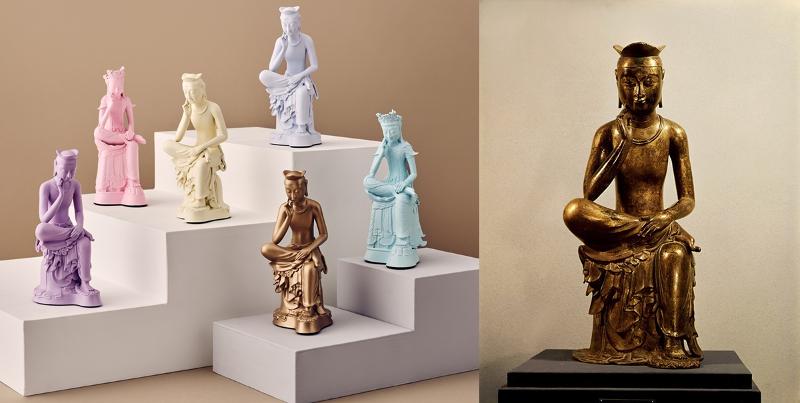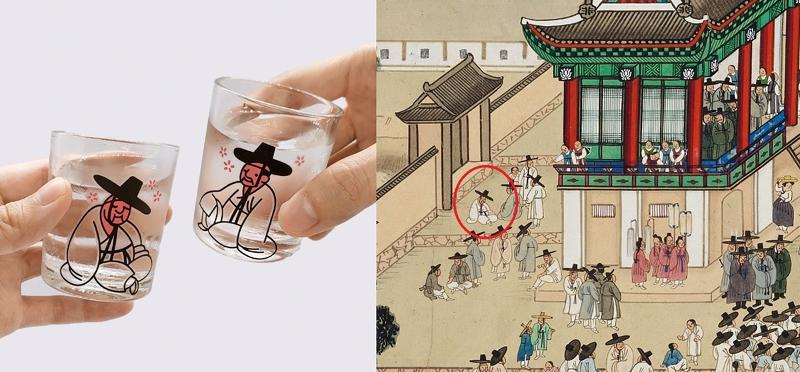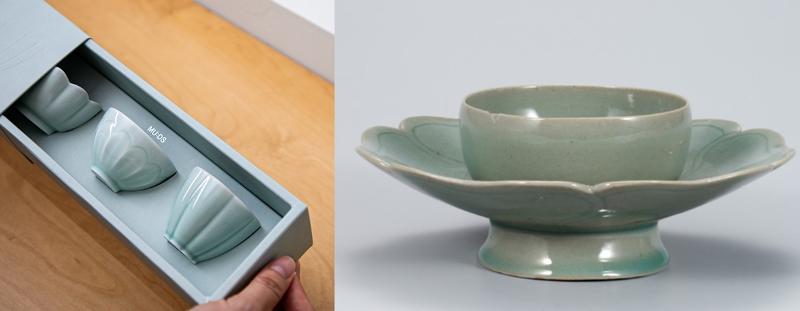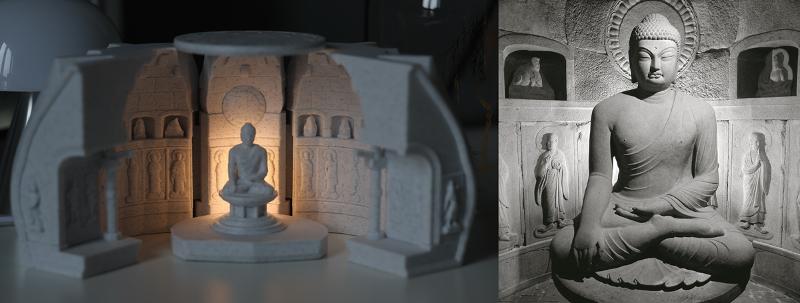By Lee Jihae
Products whose designs reflect cultural heritage are gaining popularity to the point that they have gone beyond souvenirs in fueling a cultural trend.
These items are called "muds," a portmanteau of the words "museum" and "goods" referring to cultural heritage-related items sold at museums.
As creative and practical items with a modern interpretation of the value of traditional culture, they offer an alternative means of preserving Korean history and culture in daily life.
The National Museum Foundation of Korea said sales of such products last year hit KRW 21.28 billion, up 42% from 2023 and a massive fivefold jump from KRW 3.7 billion in 2020.
The following are the top five such items by sales last year.

On the left are miniatures of the statue Pensive Bodhisattva and on the right is the original work made in the late sixth century. (National Museum Foundation of Korea and Korea Heritage Service)
Miniatures of Pensive Bodhisattva
The sculpture Pensive Bodhisattva appears to be in deep contemplation, with his right leg perched on his left knee and fingers on his right hand gently touching his cheek. The curvy lines and half-closed eyes create a delicate but outstanding expression.
Made in the late sixth century during the Three Kingdoms Period (57 B.C. - 668 A.D.), it is displayed on the second floor of the National Museum of Korea (NMK) in Seoul's Yongsan-gu District. Preserving the statue's philosophical meaning and formative aesthetics, the miniatures are popular as interior decorations that boast artistic sense.

On the left is the Drunken Seonbi's (Confucian Scholar-Official) Discoloration Cup Set and on the right is Joseon Dynasty artist Kim Hong Do's work "Welcoming Banquet for the Governor of Pyeongan." (National Museum Foundation of Korea and National Museum of Korea)
Drunken Seonbi's Discoloration Cup Set
These unique mini-glasses have seonbi (neo-Confucian scholar-official) whose face turns red when pouring a cold drink into it. The characters were inspired by those depicted in the painting "Welcoming Banquet for the Governor of Pyeongan" by Kim Hong Do, a painter from the Joseon Dynasty (1392-1910). The work shows a feast to mark the appointment of the head of Pyeongan-do, a province now in present-day North Korea, around the Daedonggang River.
The face of the seonbi changes color depending on the glass temperature, making his cheeks appear to turn red to add to the fun of inebriation. The painting is displayed at the NMK.
The glass is a modern reinterpretation of the elegance of the literati and scholar-officials of the Joseon era, showing both traditional charm and wit.

Left is a celadon cup set and on the right is a celadon cup from the Goryeo Dynasty (918-1392). (National Museum Foundation of Korea and National Museum of Korea)
Celadon cup set
Goryeo celadon is a light greenish-blue porcelain from the Goryeo Dynasty (918-1392). Baked in 1,200 to 1,300 degrees Celsius, the item requires just the right amount of oxygen in the kiln to produce the desired color. Reducing oxygen creates a deep greenish-blue color while increasing it results in a reddish- or light-brown hue.
Goryeo potters baked a celadon twice to eliminate impurities and applied thick glaze to produce the desired bluish color.
Exuding the spirit of craftsmanship, this cup set is a modern take on the style of Goryeo celadon.

Left are miniatures of the Great Gilt-Bronze Incense Burner of Baekje and on the right is the original artifact. (National Museum Foundation of Korea and National Museum of Korea)
Miniatures of Great Gilt-Bronze Incense Burner of Baekje
In 1993, the Great Gilt-Bronze Incense Burner of Baekje from the ancient Baekje Kingdom (18 B.C.-660 A.D.) was found at a temple site in the village of Neungsan-ri in Buyeo-gun County, Chungcheongnam-do Province. Perfectly preserved in form after being buried in mud for about 1,500 years, the relic displays the essence of Baekje culture, which was a fusion of Buddhism and Taoism.
The elaborate carvings include a lid with a phoenix holding under its chin a yeouiju (cintamani), or a mysterious orb or ball that is said to grant wishes, and images of the lotus flower, which symbolizes Buddhism and sinseon, or an enlightened Taoist immortal said to have miraculous powers, on the body. Also impressive is the dragon on the bottom holding up the burner.
The original artifact is displayed at Buyeo National Museum.
The miniature's rising popularity stems from its representation of the relic as celebrating both tradition and art.

On the left is a replica of a lighted Buddha at Seokguram Grotto and on the right is the original landmark. (National Museum Foundation of Korea and National Museum of Korea)
Lighted replica of Seokguram Grotto
Seokguram Grotto in Gyeongju, Gyeongsangbuk-do Province, is an artificial grotto built at a temple and a leading piece of the nation's Buddhist cultural heritage from the Unified Silla era (676-935). This masterpiece features a geometric structure and delicate sculptures forming a harmony.
Depicting the moment Buddha reached enlightenment, the work in 1995 was designated UNESCO World Heritage.
This item is a modern take on traditional architectural beauty and emits a soft light that creates an atmosphere of mystery.
Where to buy
These popular items are available at the NMK and National Folk Museum in Seoul; Gyeongju National Museum in Gyeongju, Gyeongsangbuk-do; Daegu National Museum in Daegu; Jinju National Museum in Jinju, Gyeongsangnam-do Province; Jeonju National Museum in Jeonju, Jeollabuk-do Province; Iksan National Museum in Iksan, Jeollabuk-do; Gwangju National Museum in Gwangju; Jeju National Museum on Jeju Island; and Korean Traditional Culture Center at Incheon International Airport in Incheon.
Purchase is also available online via muds.or.kr (Korean) and muds.kr (English).
jihlee08@korea.kr